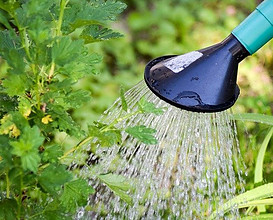 Plants can help to make your home or yard beautiful. It’s vital to know that different plants have different needs, so it can be hard to take good care of them. If you see a plant that is dying, find out why it is, water the plant well, move the plant to the appropriate environment, and monitor how the leaves are doing.
Plants can help to make your home or yard beautiful. It’s vital to know that different plants have different needs, so it can be hard to take good care of them. If you see a plant that is dying, find out why it is, water the plant well, move the plant to the appropriate environment, and monitor how the leaves are doing.
Method 1
Identifying the Challenge
1. Detect under-watering by dried-up leaves.
When the leaves of your plants are dried-up, it means that you’ve not been properly watering the plant. You will also see that the leaves of the plant are starting to fall off.
2. Feel the soil to know if it is moist.
Dip your fingers a few inches into the soil and take some so you can feel it. If the soil is very sticky and stains your skin, then you may be overwatering it. If the soil is hard and crumbles, this means you have not been watering it well, and you should do that quickly.
3. Detect overwatering by wetness and droopiness.
If your plant is rotting and droopy, it might be a sign that you’ve been overwatering it. Feeling the moisture below the surface of the soil is another method you can use to know just how wet the soil is. If the soil feels very wet, then you’re pouring too much water into it.
4. Inspect the roots to see if it’s rotting.
When you pour too much water into the soil, it makes the soil very moist and stops the plants from getting enough oxygen. Gently remove your plant from the ground or its pot to check the roots. If the roots are dark, too soft, and break when you touch them, then they are rotting.
5. Identify burnt plants by dark or bleached patches.
Plants that are exposed to sunlight often have discolored patches on their leaves. The patches can appear very dark or very light.
6. Identify early shaded plants by their pale leaves.
Your plant might be finding it hard to survive because it’s not getting enough sunlight. To know if your plant is not getting enough sunlight, the leaves will appear paler and smaller than normal.
7. Search for information on how to care for your plant.
Not all plants can care for the same way; some have special ways that they should be cared for. For example, herbs and vegetables can be exposed to plenty of sunlight, but ferns should not because they could get burnt. Check online for information to care for your plant, or go to a local nursery to ask for information.
Method 2
Watering the Plant
1. Wet the plant.
If you find out that the problem with your plant isn’t root rot, it is good that you soak your plant. Soaking the plant can help increase the health of the plant. If the plant is not in a pot or container, it is good that you water it well so the water stays on top and can no longer soak into the soil.
If the plant is kept in a pot, fill a container with cold water and put the pot in the container for a few hours.
2. Put in water-storing crystals to dehydrated plants.
If you notice that your plant is still experiencing dryness even when you water it often, put water-storing crystals into the soil. These crystals were designed to assist soil to retain water.
3. The soil should be watered, not the plant.
When you water the plant instead of the soil, it can cause the plant to get fungi infection. To prevent this from happening, it is better to water the soil instead of the plant.
4. Watch the soil closely and provide adequate water.
To water the soil properly, you need balance. You can harm your plant if you overwater it or you don’t water it enough. To ensure that your plant is getting just the right amount of water, feel the soil, and ensure that it’s dry before you water the plant.
5. Water the plant less when it is winter.
The plant should be watered less when it’s winter. The reason it shouldn’t be watered frequently is that it is dormant in winter.
Method 3
Changing the Plant’s Environment
1. Use fresh soil for Re-potting
There have been cases where the soil becomes too hard and starts to repel water. This is because it has been dry for too long. When this happens, it is better to carefully take away the plant from the pot or the ground, dispose of the soil, and replace it with new soil.
You can place the plant in a new location after you’ve seen that it could not thrive in its old location anymore.
- Indoor potted plants will need to be transported after some years.
2. Test the soil to see if it’s nutritious.
A soil-nutrient testing kit can be gotten from a local nursery. Make sure you follow the directions of the testing kit strictly. The nutrients that soil needs for plants to survive vary for different plants. Test the nutrient of the soil to know if your plant is getting enough nutrients.
- If the oxygen level of the soil is high, the leaves will grow well, but the flowers and fruits will not.
3. Run tests to know the pH of the soil.
Local nurseries also sell soil pH testing kits, or they can even come with the soil nutrient testing kit. A pH test will help you know how acidic or basic the soil is. This is vital because if the pH of the soil is not right, the plant will not be able to access nutrients.
4. Pour away the old soil and add a new one.
Your soil might be struggling because it doesn’t have enough nutrients or has none at all. If you notice that something else is affecting the health of your plant, gently take out the plant from the soil and replace the soil with a potting mix and enough nutrients.
5. Add fertilizer to the plant.
When you see that the soil of your plant is running low on nutrients, add fertilizer to the soil. A slow-release fertilizer is better because it ensures that the plant is not fed with too much nutrient at a time. Follow the direction on how to use the fertilizer so you don’t add too much.
6. Modify the soil’s pH if needed.
When you discover that the pH of your soil is too basic, add manure or an equal mixture of water and coffee to the soil. When you see that the soil is too acidic, dolomite lime and crushed eggshells can be put in the soil to raise the pH.
7. Move burnt plants to a place with shade.
When you notice that your plant is having problems because it is exposed to the sun, move it to a shaded area where it can only get limited access to sunlight.
8. Move overly shaded plants to a sunnier space.
If you see that your plant is not getting enough sunlight, carry it to a space where it can get direct access to sunlight. If the plant is indoors, move it close to your window so it can get enough sunlight.
Method 4
Taking Care of the Plant’s Leaves

1. Clear pests off the plant.
Insects like spider mites, fruit flies, etc., like to move towards plants. To stop them from destroying your plant, clear them away by wiping them off with a moist towel when you see them on your plant.
2. Cut off the dried part of the plant.
If you see that there are a lot of dead leaves and stems on your plant, cut them off. This will allow nutrients to go towards the healthy parts of your plant.
3. Spray water on your plant if it is kept indoors.
Put tap water inside a bottle and spray lightly on your plant frequently. This will provide the plant with needed humidity and also stop the leaves from getting too dry.
Conclusion
This article aims to enlighten you on how you can revive the health of a dying plant. The article is well-fed with details and tips that cannot be overlooked. It also features four methods on how to bring your plant back to life.
Thank you so much for your time reading this article if you have questions about this please leave a comment below and I’ll be happy to write back to you.

Josephine
Hello Everyone!
The entire team of My Amazing Garden is thrilled to WELCOME you on board. We hope you’ll do some amazing works here and enjoying reading the informative and helpful articles that we really love to offer to every one of you: a warm welcome to you and lots of good wishes for becoming a part of our growing team. I wish you a prosperous new year 2021!
Best wishes,
Josephine
TheMarketingLord
Awesome article, very interesting.
It is just the thing I was looking for online.
You have really put in a lot of work to write this, and I respect that.
I am glad that I stumbled upon your article because you gave me many values and tips that I needed.
Thank you for that, and I wish you all the best in the future and your business.
Keep up the good work.
admin
Hello, Thank you so much for your kind comment about How to Revive a Plant. Thanks to that, you find it helpful for your future gardening needs. Thanks a lot.
Joyce
Julai
Thank you for this detailed post on how to revive a plant. I have some plants that I brought indoors when winter started, and they’re not in very good condition. Maybe because of the hot temperature inside the house. But, I am scared to leave them outside because last winter I just left them, and they looked dead. I repotted them, and fortunately, they came back to life during the summer. Excited to bring them back outside again.
admin
Hi, Julia,
Thank you so much for your time reading my article about How to Revive a Plant.
Thanks to that, you found this article helpful and using it in your future guide to reviving your plants. Good luck.
Thanks,
Joyce